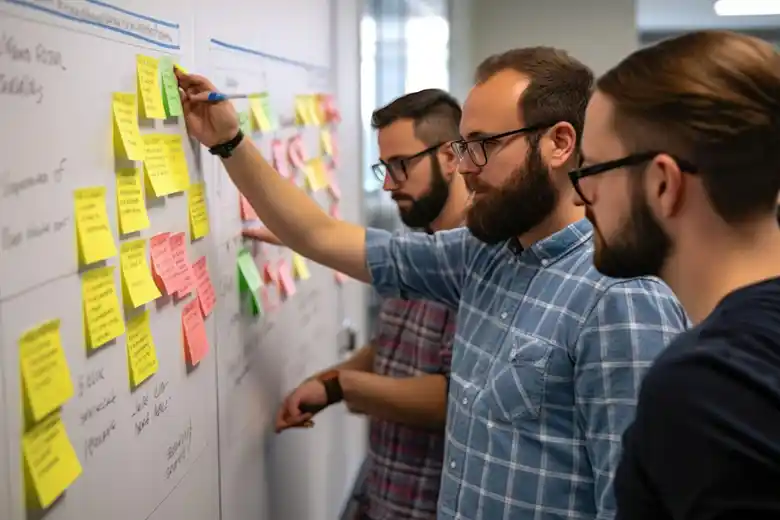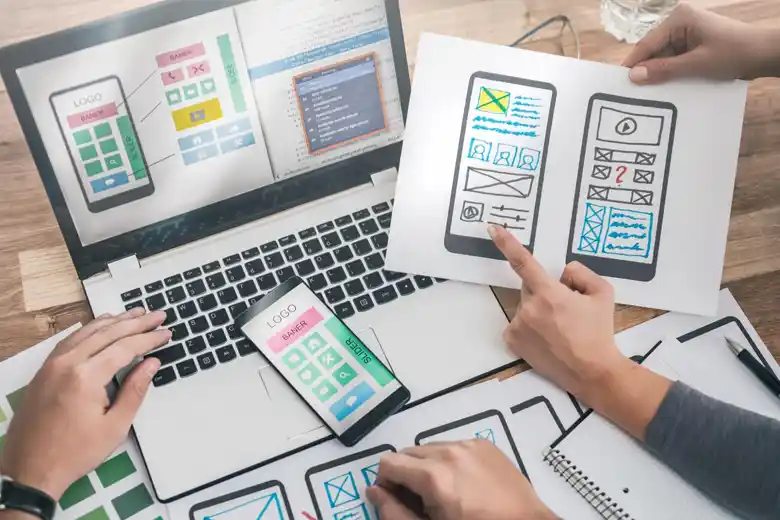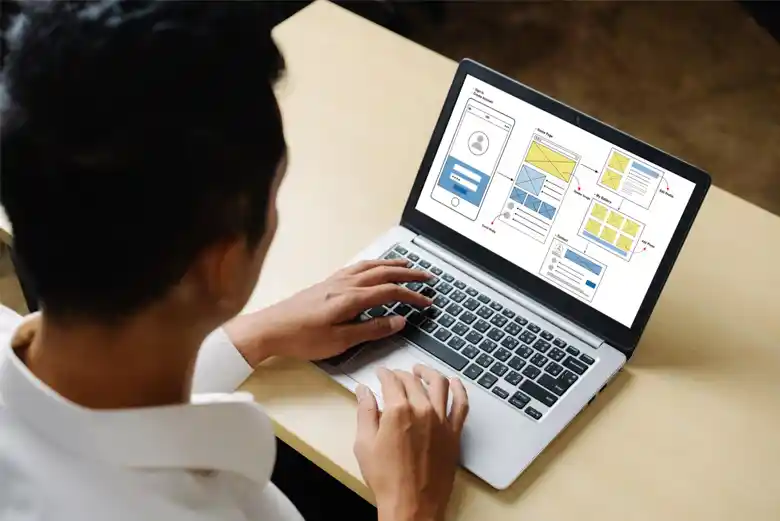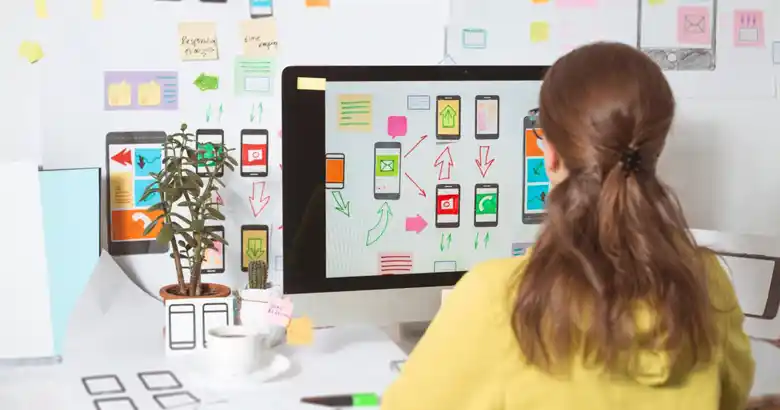In this ultimate guide to UX design, you’ll learn everything you need to know about this exciting field –from UX design principles, processes, and project types, to career options, digital tools, and key skills.
UX design has been getting a great deal of attention in recent years. And there are good reasons for it! As a proven methodology for engaging and retaining users, boosting revenue, and solving user challenges both big and small, it’s an approach to product design that companies can no longer afford to ignore. With organizations the world over offering enticing packages and competitive salaries to those with UX design skills, now is a great time to consider learning more about UX design and if the role of UX designer could be a good fit for you.
Here’s a clickable list of what we’ll be covering in this article, so you can jump straight to the section which sparks your interest:
- 1) What is UX design?
- 2) A brief history of UX design
- 3) What does a UX designer do?
- 4) What’s the difference between UX and UI design? ,
- 5) Careers in UX design
- 6) Why is UX design important?
- 7) How to become a UX designer?
- 8) Conclusion
What is UX design?
UX design–short for user experience design–is a practice that seeks to improve or enhance a user’s experience and interactions with websites, apps, products, and services. Although a unique discipline in and of itself, UX design contains many elements from other practices such as standard design, market research, and even psychology. A UX design team will validate decision-making by conducting extensive research, data analysis, testing, and validation, with the user and usability of a product at the front and centre of everything they do.
The Interaction Design Foundation, a leading collective in UX design thinking, defines UX design as:
“The process design teams use to create products that provide meaningful and relevant experiences to users. UX design involves the design of the entire process of acquiring and integrating the product, including aspects of branding, design, usability and function.”

A brief history of UX design
Are you curious to know how UX started? Here’s a brief history of its origins and how it came to be a well-known methodology and set of principles that we know today.
- Some of the most basic principles of UX design can be traced back as far as 4000 BC to Feng Shui in ancient China–a philosophy that concerns itself with the harmonious and optimal arrangement of a person’s belongings and surroundings.
- The arrival of personal computers in the 1970s saw psychologists and computer programmers begin working together to develop what is now called the user experience, with Xerox’s Palo Alto Research Center (PARC) leading the way.
- The release of Apple’s original Macintosh computer in 1984, with graphical user interfaces, a built-in screen, and a separate mouse, saw further developments to user-focused interactions with a personal computer.
- The phrase “user experience design” was coined by Don Norman in 1998 in his book “The Design of Everyday Things” which marked a shift away from a user-focussed system of design towards an approach that placed the user at the front and centre of every design.
- By the early 2000s, it was clear that Apple’s work in UX hadn’t ended with the development of the Apple Macintosh personal computer. The company became famous for its innovative UX designs of the Apple iPod (2001) and the iPhone (2007), cementing the computer giant’s reputation as a UX leader.
- As we look to the future of UX, AI is likely to play a huge role. Conversational design, knowledge of psychology, and ethical design practices will be highly valued in this new era of design and interaction. Service design and design for public policy will also get more investment, as governments seek to create more equitable policies and programs for their communities. UX designers will also need to broaden their skill sets to work with mixed realities, as technologies such as AR and VR begin to take more central roles in both augmenting existing activities and providing opportunities in marketing and storytelling.
What does a UX designer do?
A UX designer works either alone or as part of a wider UX design team to enhance or improve a product or service and create a user-centric and intuitive experience for those interacting with it. Focusing on functionality and usability, the UX designer works on customer touchpoints with a brand throughout their journey on a website, app, or other digital interfaces. A UX designer will employ a range of UX methodologies, such as user research and testing, as they seek to fully understand the target user’s desires, goals, pain points, and general behaviour. This data will be used by the team to directly inform the design of the product so that it best meets the user’s needs.

UX design process
The UX design process consists of an array of UX methodologies which are put into practice sequentially by the UX design team. This step-by-step approach is used to address everything from entire projects to smaller user challenges, with the goal of building the most delightful user experience possible. Here’s a rundown of the stages and steps involved:
Stage 1: Definition and scope of the project
A UX designer will seek to define and scope out the project as their first step when beginning any new project or problem-solving exercise in order to fully understand the challenges which will need to be addressed. Common methodologies for getting a good understanding of the target user at this stage include creating user personas, journey maps, and empathy maps, while processes used to understand the needs, goals, and limitations of the business include conducting stakeholder interviews, identifying value propositions, and holding a kick-off meeting.
Stage 2: Research
Research is a fundamental aspect of the UX design process as it enables design teams to remove assumptions, prioritize concepts and features, and fully comprehend the user’s challenges. Put simply, it helps narrow the focus of the whole design to the core elements which need to be addressed. User research, market research, and competitive research are typically conducted at this stage to enable the team to gather as much information as possible.
Stage 3: Design
This stage of the UX design process involves the team creating wireframes and prototypes of the first iterations of the design, based on the gathered research. Designers often use digital tools such as Figma, UXPin, and Balsamiq to create wireframes, and prototyping tools including InVision Studio, Adobe XD, and WebFlow. Multiple iterations of a design can be made at this stage before the team works together to validate the design, align all the concepts, and pass the final version over to the development team to be built.
Stage 4: Implementation
Implementation is when the design team hands over the specifications of their website or app design to the development team to be programmed. Using clear communication and collaboration skills, the design and development teams work together at the start of implementation to clarify technical specifications and limitations and figure out a realistic timeline for the finished project.
Stage 5: Validation and usability testing
This last step in the UX design process is concerned with validating the design by testing it with real users. Usability testing is often conducted at the pre-launch stage, with design teams adopting methodologies such as user observation, surveys, interviews, and card sorting to get detailed feedback from real users that can be used to further tweak and improve the design before launch.
How UX designers incorporate Design Thinking into their work
Design Thinking is a critical component of the work of UX designers. With a focus on the human experience, Design Thinking is an ideology that informs innovation and design. The approach revolves around five central elements: empathize, define, ideate, prototype, and test. Rather than a strict methodology or set of steps, these elements consist of best practices and principles for UX designers to consider while following a specific structure or the UX design process.
While the intent behind Design Thinking and UX design is similar–putting the needs of the user first in order to create enjoyable and seamless user experiences and products–Design Thinking is generally used at a more strategic and conceptual level while UX design is implemented on a more tactical, everyday level.
UX design principles
UX design principles are guidelines that UX teams use to ensure intuitive and user-centric designs that provide the best user experience possible for website or app visitors. These best practices form the backbone of the discipline and are a great resource for UX designers when navigating different challenges. The following are the seven most commonly adhered-to principles of the profession:
User-centricity
The user’s needs and challenges should always be at the centre of a UX designer’s work. Through the implementation of extensive user research and testing to uncover user preferences and behaviours, the design team is in a much better position to improve the user’s overall experience of a product or service.
Hierarchy
Both the visual hierarchy and organizational hierarchy of content are crucial to the user’s ability to navigate a website or application and achieve their goals. The former refers to how content is visually prioritized on a page, while the latter is concerned with structure and labelling.
Consistency
When a website is familiar to a user and consistent with their experiences of other, similar websites, they can reach their goals faster and more intuitively. The user’s experience within the website should also be consistent, with their digital experience remaining the same across all pages and with all elements.
Accessibility
Designs must be accessible to everyone, irrespective of access limitations or disabilities. Best practices which can guide this principle include ensuring the readability of website copy and using contrasting colours and elements which aid visibility.
Context
Honouring the context means a design team needs to think carefully about the interfaces or digital devices their target user is typically interacting with, why a user is interested in the product or service (or what problem they are trying to solve), and what experiences of other products or services they are bringing with them to this interaction.
Narrative
Using photographs, illustrations, videos, animation and text, a UX designer will build a narrative around a brand in order to bring about an emotional response from the user. When implemented successfully, good storytelling leads to customer conversions and encourages brand loyalty.
Visual design system
A visual design system is a standardization of logos, graphics, motion and interactive elements, typography, colours, layouts, formats, photography, data visualization images, or illustration that are kept consistent throughout the design of a website, app, or other digital experience so that they align with and support the brand identity.
For more detail on each principle, check out our article: UX Design Principles and How to Apply Them

UX design projects
When you begin working in UX design, you’ll be expected to turn your hand to different types of projects depending on the needs of the company or client. Here are just some of the types of projects you can look forward to working on.
Website
UX designers are likely to spend the majority of their time designing and improving websites for employers or clients, focusing on elements which directly impact the user’s ability to reach their goals, such as completing a purchase or signing up to a service. To ensure a delightful and intuitive experience for website visitors, a UX designer will concentrate on creating a logical hierarchy of text and visual information, straightforward navigation, clear labelling, and images and elements that provide context and familiarity.
App
Mobile app development is another area within which UX designers are hugely sought after. The usability of an app’s interface is a large contributor to how likely it is that users will adopt and interact with the app. If the usability or overall user experience is poor, an app will be quickly abandoned in favour of competitors offering a more streamlined experience. In a similar vein to the UX required for website design, a UX team working on app development will focus on creating the most optimal user journey via logical visual and text hierarchies, seamless navigation, and intuitive interactions with each element, all designed with a mobile interface in mind.
Software design
UX designers are frequently required to work on the design of different types of software, such as CRMs (Customer Relationship Management tools) and emailing software. Here, the UX designer can help ensure the design’s goals are aligned with those of the user, and that the usability and functionality of the design is centred around enabling the user to reach their goals. Ultimately, the UX designer seeks to create software interfaces that are both effective and easy for users to interact with.
Service design
Service designers work on designing services and experiences, such as how visitors check into a hotel or how customers find what they need in a pharmacy or supermarket. However, the work of service designers isn’t limited to offline experiences; for example, a service designer might work on a POS interface. As Wikipedia states: “Service design is the activity of planning and arranging people, infrastructure, communication and material components of a service in order to improve its quality, and the interaction between the service provider and its users.”
Voice design
With the exponential rise of voice interfaces, the need for voice UX designers is also steadily growing. Voice design is concerned with the design and creation of voice user interfaces, whereby users can search, send messages, and control connected devices all through voice instruction alone. The focus therefore for voice UX designers is to enable the most conversational and user-centred experience possible through, for example, the creation of accurate personas, and the designing VUI dialogues that resonate with users.
AR / VR design
With AR and VR becoming increasingly mainstream, demand for UX designers with experience in these areas is also on the rise. UX design for Augmented Reality (AR) and Virtual Reality (VR) focuses largely on giving the user the feeling of being in control of the product or experience, the user’s interactions within the experience, and visual assets. The job of the UX designer is also to try to eliminate any distractions coming from the user’s immediate environment which are irrelevant to the experience being created.
Product design
Product design and UX design have many similar principles and practices, however, product design tends to be more focused on the design of physical products while UX designers are more likely to work on digital products and services. Although product design is often seen as a separate area of expertise to UX design, specialist UX designers are sometimes brought in to help with the design of physical products owing to their expertise in areas such as user needs and the customer journey.

Does a UX designer need to be able to code?
The role of the UX designer does not typically require coding skills. However, due to the close relationship between the design and development teams, it is extremely useful for UX designers to have some basic coding skills as these can assist in understanding the limitations and possibilities of the development team. This knowledge is also useful for writing design specs that contain all the information and guidance a development team needs in order to adhere as closely as possible to the concept the design team is hoping to realize.
Key tools in UX design
UX designers have an array of tools available to them to help with research, user testing, wireframing and prototyping. We’ve put together some of the most commonly used digital tools here:
Research tools
For validating prototypes and testing designs, Maze is a popular choice, while Loop11 generates surveys and user tasks. Qualitative research tool Dscout gives researchers key insights into the user experience, while Ribbon is a great interviewing tool.
Wireframing tools
For the creation of low-fidelity wireframes, Sketch and Figma are popular with designers, while Adobe XD and Framer assist design teams hoping to create more detailed, high-fidelity wireframes. For more general digital sketches, many designers opt for Balsamiq Wireframes, while Lucidchart assists in the creation of professional flowchart diagrams.
Prototyping tools
InVision is perhaps the most well-known prototyping tool available, with design templates as well as collaboration and testing features on offer to users. Origami Studio is a prototyping tool for building and sharing interactive designs. Axure RP enables the creation of interactive prototypes, and Principle provides support for designers looking to animate and build interactive user interfaces.
Testing tools
For data on user behaviour, Hotjar is a popular testing tool, while Lyssna is a great resource for research, tests, and surveys. UserZoom and UserTesting enable usability testing by helping designers receive direct user feedback on their designs.
What’s the difference between UX and UI design?
Although it can sometimes be hard to distinguish between UX and UI design, they play very different roles in the design process. UX design is interested in the user’s entire experience or journey with a product, including how interacting with that product or feature makes a user feel, and how usability and functionality can be optimized to enable the user to reach their goal as quickly and intuitively as possible. However, UI design–short for user interface design–refers specifically to the visual elements of an interface or page, such as buttons and icons. The UI designer is interested in the look and feel of these elements, and how they behave when a user interacts with them.
Here are some more of the key differences between the two fields:
- While UX design makes interfaces and experiences useful and intuitive, the role of UI design is to make those interfaces aesthetically appealing.
- UX aims to help users accomplish their goals through great navigation, clear and consistent labelling, and content organized in a way that makes sense to the user. UI design, on the other hand, is concerned with helping a brand or company build emotional connections with its audience through the use of visuals and text.
- As UX design is concerned with function and usability, it is usually done first. The UI designer comes to the interface once it has been tested and validated, to work on the visual design of specific elements and to enhance micro-interactions.

Careers in UX design
Due to the surge in demand for UX designers around the globe, those with the right skills in the field can expect competitive salaries from a wide range of both small and large companies once they have a rounded education and some hands-on experience behind them. Working freelance is also an attractive option for UX experts, a choice which enables an individual to work on a variety of projects for different clients–companies, individuals, NGOs, and government organizations–while still retaining their professional independence and work-life balance.
While salaries will, of course, be dependent on where in the world an individual is living, it’s fair to say that UX designers and others on the UX team can expect to be well compensated the world over.
Here’s an overview of average salaries for mid-level UX designers in different countries:
India: ₹10,00,000
US: US$105,122
Canada: CA$77,090
Germany: €52,865
UK: £48,755
As we’ve mentioned, the UX designer isn’t the only role available for those with skills in the field. Let’s look in a bit more detail at some of the other roles you might find working on the UX team.
UX strategist
The role of the UX strategist is to inform and guide business decisions from the perspective of the target user group, in order to boost business performance by aligning business decisions with the goals of the user.
UX researcher
The UX researcher is responsible for finding and identifying the target user’s preferences, pain points, goals, and general behaviours. They then use this data to inform the products and services being designed by the team. The UX researcher will use both qualitative research methods such as observing users, conducting interviews, and hosting focus groups, and quantitative research methods, such as online and offline surveys.
UX writer
Carefully crafted and compelling copy is key to attracting users and guiding their journey through your site or application. This is where the UX writer comes in. The UX writer provides engaging and clear navigational texts and labels for apps, websites, and other interfaces to ensure the user knows exactly where they are in the interface and where they need to go next to reach their objective.
Information architect
The information architect’s role revolves around how content is organized and displayed on a website or app. By conducting extensive research and user testing, the information architect knows how to best structure and label content in the most effective way, helping users complete tasks and find what they need.
Why is UX design important?
You might be wondering why UX design has gained so much attention in recent years. Well, in an age where all it takes for a user to switch products or services is the swipe of a thumb or a few clicks, getting micro-interactions spot on through expert UX design has become a necessity. Besides, it is clear that the practice brings a host of benefits to both users and businesses alike. Here are just some of the advantages of implementing a user-focused approach in a product’s design:
Ease of use
UX design’s goal is to increase usability and enhance the experience of interacting with a digital product for users. When such a product, say a website, becomes easier to use, users are more likely to complete their goals, convert to customers, and remain loyal to the brand.
Boosted revenue
Accessible and intuitive user experiences attract more visitors who, in turn, spend longer on the site or application, enjoying their interactions and reaching their goals. When users spend longer enjoying a site they are more likely to be converted into customers, which boosts revenue.
Quicker to market
Development time and costs can be significantly reduced when the UX design process has been properly followed. When this is the case, a product can be released to the public much more quickly than when a UX approach isn’t incorporated.
Improved customer retention
High-value yet simple user experiences that are punctuated by positive interactions and which enable users to achieve their goals are remembered by users who return again and again to that brand and their products.
Boosted customer loyalty
Customers tend to stay loyal to the companies which have provided them with the best possible experience. Building on this, they might even write positive testimonials online, or recommend the company to their personal or professional network.
How to become a UX designer
If learning about the field of user experience design left you wanting to learn more about becoming a UX designer yourself, then you’re in the right place. Here are our key pieces of advice for those looking to launch a career in the field. (For even more detail, check out our article How to become a UX designer in 2023.)
Key skills
If you’re looking into launching a career as a UX designer you’ll need to be prepared to onboard the technical and soft skills required to support your team. From the technical side, employers will expect candidates to have experience and knowledge in user research, wireframing, prototyping, mock-ups, user flows, information architecture, and user testing. Some will also expect their UX designers to have knowledge of app development and coding. Among more transferable skills, the requirements of the field include collaboration and communication skills, empathy, curiosity, critical thinking, and task prioritization. Check out our article covering these skills in more detail: Which UX Designer Skills Do You Need in 2023? A Complete Guide .
In addition to these key skills, employers will want to see that you have a good understanding of the key UX principles and the UX design process which guides the team from start to finish on each project. This means that you need to have practical experience in each of these skills. To give you an idea of what the research aspect of a project might look like, take a look at AND learner, Aromal Jose Baby’s User Research and Analysis project.
Learning options
As we have seen, many of the skills required of the UX designer are transferable from other careers. However, there are also a number of specific talents a UX designer will need to embody which can only be acquired through some sort of formal training or education due to the complexity of the field. Luckily for prospective designers, there are a variety of ways to onboard these skills, both in person and online. Let’s take a look at what learning options are available to you.
Self-study
Those looking to learn UX design without the support of a formal curriculum and teacher can onboard some of the key practices and principles they need to know by absorbing relevant blogs, podcasts, and books on the subject.
Here are some of our top recommendations:
UX design blogs
UX Booth
UX Movement
UX Magazine
UX Planet
Smashing Magazine
Usability Geek
UX Planet
Nielsen Norman Group
UX design podcasts
UX Podcast
What is wrong with UX
The Design Better.co podcast
The UX Intern
UX like us
UX Collective
99% Invisible
UI Breakfast: UI/UX Design and Product Strategy
Design Matters
UX design books
100 Things Every Designer Needs to Know about People by Susan M. Weinschenik, Ph.D.
The Design of Everyday Things by Don Norman
Emotional Design by Don Norman
Don’t Make Me Think (Revisited) by Steve Krug
Smashing UX Design: Foundations for Designing Online User Experiences by Jesmond Allen and James Chudley
A Project Guide to UX Design by Russ Unger and Carolyn Chandler
Online courses
If you’re serious about breaking into a career in UX design, one of the most effective ways of doing so is by taking a course. Not only will you learn the theory of UX, such as the key skills, principles, best practices, and processes, but you’ll also get the practical experience necessary to land your first position in the field, by working on projects and using digital tools.
In addition, many courses offer the support of teaching staff or mentors, help you build a professional portfolio that helps you get hired , have engaged student communities which you can join, and support you in your applications and interviews when you start looking for a job. Finally, a large number of courses provide a certificate of completion to successful students, which provides potential employers with a guarantee of your skills and knowledge when inviting you to an interview.
If you’d like to receive professional support to learn the essential skills and industry knowledge needed to succeed as a UX designer, check out AND Academy’s UX UI Diploma course , which comes with dedicated placement support and a job guarantee.
Conclusion
In this article, we’ve run through everything you need to know about UX design, from its history, process, principles, and job roles to the key skills, tools, and learning options you’ll need for launching a successful UX design career. With technology becoming a mainstay of our lives, UX design will continue to be crucial to businesses. And hence, if there’s ever been an exciting time to join this field, it’s now.
Here are some additional resources that may be useful in your learning efforts:
- Watch this session by Shiva Viswanathan, Design Head of Ogilvy Pennywise, and Naman Singh, Product Experience Designer at RED.
- Talk to a course advisor to discuss how you can transform your career with one of our courses.
- Pursue our UX UI Design courses – all courses are taught through live, interactive classes by industry experts, and some even offer a Job Guarantee.
- Take advantage of the scholarship and funding options that come with our courses to overcome any financial hurdle on the path of your career transformation.
Note: All information and/or data from external sources is believed to be accurate as of the date of publication.










